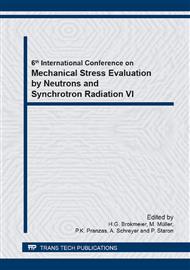p.143
p.149
p.155
p.161
p.167
p.173
p.181
p.187
p.193
Through Thickness Residual Stress Measurements by Neutron Diffraction and Hole Drilling in a Single Laser-Peened Spot on a Thin Aluminium Plate
Abstract:
Residual stress measurements are very challenging in thin aluminium plates. Rolling-induced crystallographic texture can lead to an S-shape fit when using the sin2ψ method for surface X-ray diffraction. Peak broadening and missing peaks can also be observed for synchrotron X-ray diffraction with conventional θ/2θ scanning due to texture. In addition, when measuring near the plate surfaces, partially-filled gauge volumes in diffraction experiments will lead to “pseudo-strains”, an apparent shift between measured and actual positions for the diffraction peak. Obtaining a meaningful value of d0 for strain calculations is another issue for diffraction experiments in thin plates. The low thickness also offers challenges for destructive methods including incremental hole drilling, i.e. there is no defined ASTM standard for measuring non-uniform residual stress profile for thin plates. In this work, 2-mm-thick Al2024-T351 plate was investigated for residual stress fields due to laser peening. Neutron diffraction measurements were carried out at POLDI (Pulse Overlap time-of-flight Diffractometer) in PSI, Switzerland and the results are compared with incremental hole drilling.
Info:
Periodical:
Pages:
167-172
Citation:
Online since:
November 2013
Authors:
Price:
Сopyright:
© 2014 Trans Tech Publications Ltd. All Rights Reserved
Share:
Citation:


